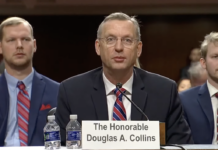
(GA Recorder) — Azo Tobe Yubo was all smiles last month as she walked out of Center Parc Stadium in her blue cap and gown, her mother on one side and her young daughter on the other.
Tobe Yubo wants to be a teacher, and her associate’s degree from Perimeter College at Georgia State University is the key to her dream job.
Finishing the degree was not always easy, and Tobe Yubo said at first, she did not think she would be able to afford to start college.
“The biggest challenge for me starting was financial,” she said. “But once I started knowing that there are programs or scholarships out there that can help me pay for my college, it made the transition to finishing college a little bit easier.”
The White House hopes to help more people start college through a provision in the $1.8 trillion American Families Plan to provide two free years of community college to all Americans. It calls for $109 billion for two years of free community college and another $62 billion to increase completion and retention rates.
Low-income students have access to programs to help pay for college, including Pell grants, which are used by more than 3 million community college students each year, according to the Association of Community College Trustees.
In-state tuition at a community college in Georgia costs about $3,000 on average, according to EducationData.org, and the maximum Pell Grant award is just under $6,500.
But Pell Grants are not available to everyone, and research suggests that murkiness around college costs and financial aid discourages students from applying or accepting.
A National Bureau of Economic Research study found that simply telling low-income, high-achieving students early in their senior year of high school how much financial aid they could receive rather than waiting until after they sent an application made them substantially more likely to apply, from 26% to 68%, and to enroll, from 12% to 27%.
Money just the beginning
Enrolling is only the first step toward graduating, and community college students face other challenges on the road to completing their degrees, said Jennifer Lee, Senior Policy Analyst at the Georgia Budget and Policy Institute.
Only 28.2% of students who began full-time degree programs at two-year public colleges in 2016 had graduated after three years, according to the National Center for Education Statistics. Among Black students, the number is even lower, 17.7%.
In 4-year public colleges, 62.4% of students enrolled in 2013 had graduated after six years.
In a 2019 survey by North Carolina State University, about 34% of community college students listed work obligations as a top challenge to their success, the same percentage as those who listed paying expenses. Family and friends came closely behind, with 30% of respondents.
Community college students are more likely to come from rural areas, to be from lower-income families, or to be older adults looking to start a new career, all factors that make it harder to earn a diploma, Lee said.
“If you’re a full-time traditional student, that’s your primary focus, and your primary role in life at that point is to finish college,” she said. “But what you see with a lot of students who are in community colleges is that they’re a student, but they’re also something else, and some of those different pressures and balancing those different roles can really get in the way.”
Tobe Yubo said she had to take some of her classes online to care for her daughter, and she doesn’t know what she would have done if she hadn’t had her mother to help babysit.
For others, the biggest challenge is balancing studying with work. About 80% of community college students work, with 39% working full-time.
Perimeter nursing graduate Jilvonda Koonde said she was lucky to be able to work in the medical field while studying, but working meant she had to rearrange her class schedule and use more financial aid.
“It was definitely something I had to learn how to balance, but I kind of figured it out towards the end,” she said.
The COVID-19 pandemic made life more difficult for this year’s graduates, said health science major Grace Mbenza.
“My biggest challenge is when we moved everything online due to the COVID-19. It was really hard because it was the first time for me to deal with that,” she said. “But the system was very able to give us all the things we needed in order to have good grades and to keep on going learning.”
The whole package
If it finds support in Congress, the White House plan could be helpful in encouraging more students to enroll in community college, but there are other steps schools can take to help ensure those students leave with a diploma or transfer to a four-year college.
“Money certainly helps, and I think it sends the right message in terms of making it known that postsecondary is important and something that we as Americans or as Georgians support,” Lee said. “But I think there’s certainly other ways that communities and schools can plug in to support students on that more human level.”
Lee offered the example of a program at Central Georgia Technical College that provides low-cost child care for students, backed up by state and federal grants.
In 2016, Georgia Perimeter College merged with the four-year Georgia State University. The merger appears to have helped the two-year college boost its graduation rate, from 6.5% in 2014 to 14.9% in 2018.
Georgia State University officials believe its predictive analytics system is a major factor in improving graduation rates. It’s a digital system that tracks the academic performance and choices of all of the school’s more than 54,000 students, alerting advisors of potential problems before they become severe enough to cause the student to drop out.
Other community college programs have increased their graduation rates by offering social and financial support in addition to academic help, Lee said.
Nationwide, one of the most cited success stories is at the City University of New York Accelerated Study in Associate Programs, which provides so-called wraparound services including individualized class schedules and advice, gap scholarships to help cover the costs of books, and fees and unlimited public transportation cards for all students.
The program boasts a three-year graduation rate three times higher than the 16% graduation rate of other urban community colleges.
“One little piece can make a difference, but certainly it’s much more effective to have the whole package,” Lee said. “It’s everything from the academic support, mentoring and advising, but also sort of the life aspect, like transportation or child care. It’s just thinking holistically about what students need to be able to focus on their studies and get through.”







